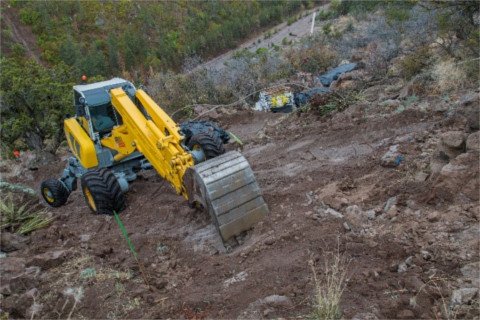
The central LANL technical area is featured in this aerial view. Boundary Peak, separating the Santa Fe National Forest and Bandelier National Monument, dominates the horizon.
The Environmental Management Los Alamos Field Office (EM-LA) is dedicated to the cleanup of legacy contamination of radioactive and chemical waste resulting from past practices during the Manhattan Project and Cold War era at Los Alamos National Laboratory.
The EM-LA cleanup scope includes legacy waste remediation and disposition, soil and groundwater remediation, and the demolition, deactivation and disposition of material from disused buildings.
Legacy Waste
After the radiological event on February 14, 2014 at the Waste Isolation Pilot Plant (WIPP), Department of Energy (DOE) scientists from several national laboratories conducted extensive experiments and modeling studies to determine what caused the drum...
Environmental Management Los Alamos Field Office
March 1, 2016Providing Additional Pressure Relief to the Remediated Nitrate Salt
In the time since the WIPP event, comprehensive measures have been employed to ensure the RNS drums remain at a safe temperature. Additionally, in the summer of 2015, LANS installed a supplemental cooling system in the contamination-control structure where the RNS drums are stored. The temperature of the RNS drums are monitored and inspections are conducted daily.
In addition to the remediated nitrate salt (RNS) waste at the Laboratory, similar drums are underground at WIPP and at Waste Control Specialists (WCS) in Andrews, Texas.
Environmental Management Los Alamos Field Office
March 1, 2016Remediated Nitrate Salt Drums Storage at Los Alamos National Laboratory
As a part of its national security mission, the Laboratory conducts research that generates waste contaminated with radioactive isotopes. During operations, waste is processed, packaged, and shipped to licensed disposal facilities.
Soil & Groundwater
Chromium Project FAQ Fall 2017
Environmental Management Los Alamos Field Office
December 15, 2017Chromium Project FAQ Fall 2017
Chromium Project Fact Sheet Fall 2017
Environmental Management Los Alamos Field Office
November 30, 2017Chromium Project Fact Sheet Fall 2017
From 1956 to 1972, a non-nuclear power plant at Los Alamos National Laboratory periodically flushed water out of its cooling towers into Sandia Canyon. The water contained chromium, which was commonly used throughout the industry as a corrosion inhibit...
Environmental Management Los Alamos Field Office
December 31, 2015Addressing Chromium in Groundwater
From 1956 to 1972, a non-nuclear power plant at Los Alamos National Laboratory periodically flushed water out of its cooling towers into Sandia Canyon. The water contained chromium, which was commonly used throughout the industry as a corrosion inhibitor in cooling tower systems.
One of the Laboratory’s highest environmental priorities is addressing the chromium plume in the regional aquifer beneath Mortandad Canyon and Sandia Canyon.
The Laboratory is taking action as part of its commitment to protect groundwater and the health and safety of New Mexico residents and the environment.
Environmental Management Los Alamos Field Office
December 31, 20152015 Chromium Environmental Assessment Public Meeting Posters
The near-term goal of the Chromium Project is to prevent migration of the chromium plume while the Laboratory assesses the best possible cleanup method.


